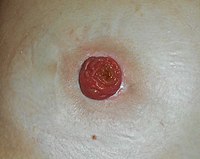
Photo from wikipedia
Hartmann’s procedure is commonly performed emergently for infectious, inflammatory, or malignant processes. Most patients historically do not undergo reversal, and those who do have been found to suffer significant morbidity.… Click to show full abstract
Hartmann’s procedure is commonly performed emergently for infectious, inflammatory, or malignant processes. Most patients historically do not undergo reversal, and those who do have been found to suffer significant morbidity. The aim of this study was to study factors associated with complications after Hartmann’s reversal and to provide information and guidance to surgeons. A retrospective review of patients undergoing Hartmann’s reversal between May 2002 and October 2017 was conducted at a tertiary medical center. Data included patient characteristics at the time of surgery and intra- and postoperative complications. Chi-square test was used for categorical variables. The Wilcoxon signed rank or t test where appropriate was used for multivariate analysis. Two hundred forty-nine patients were included. Mean age at reversal was 58.8 years, and 114 (58%) were male. Sixty-two (31.8%) patients experienced a major complication following reversal. Eight (4%) patients had an anastomotic leak. Thirteen (6.67%) patients had an intra-abdominal abscess which required either IR or operative drainage. Patients who experienced a major complication were more likely to have an ASA 4 at time of reversal (14.3% vs. 4.24%, p = 0.019), liver disease (6.6% vs. 0.8%, p = 0.021), and BMI < 30 (35% vs. 17.3%, p = 0.020). Nearly one-third of patients who had reversal surgery experienced a major complication. Four percent of patients undergoing reversal had an anastomotic leak, comparable to previously reported rates. Patients with ASA 4, liver disease, and BMI < 30 were at higher risk of a major complication following reversal. Patients who underwent laparoscopic reversal had no significant difference in outcomes. What does this paper add to the literature? The decision of whether to reverse a colostomy after Hartmann’s procedure. Our study aims to identify risk factors associated with complications after Hartmann’s reversal to better guide surgeon’s facing the dilemma of whether or not to reverse the stoma.
Journal Title: International Journal of Colorectal Disease
Year Published: 2020
Link to full text (if available)
Share on Social Media: Sign Up to like & get
recommendations!